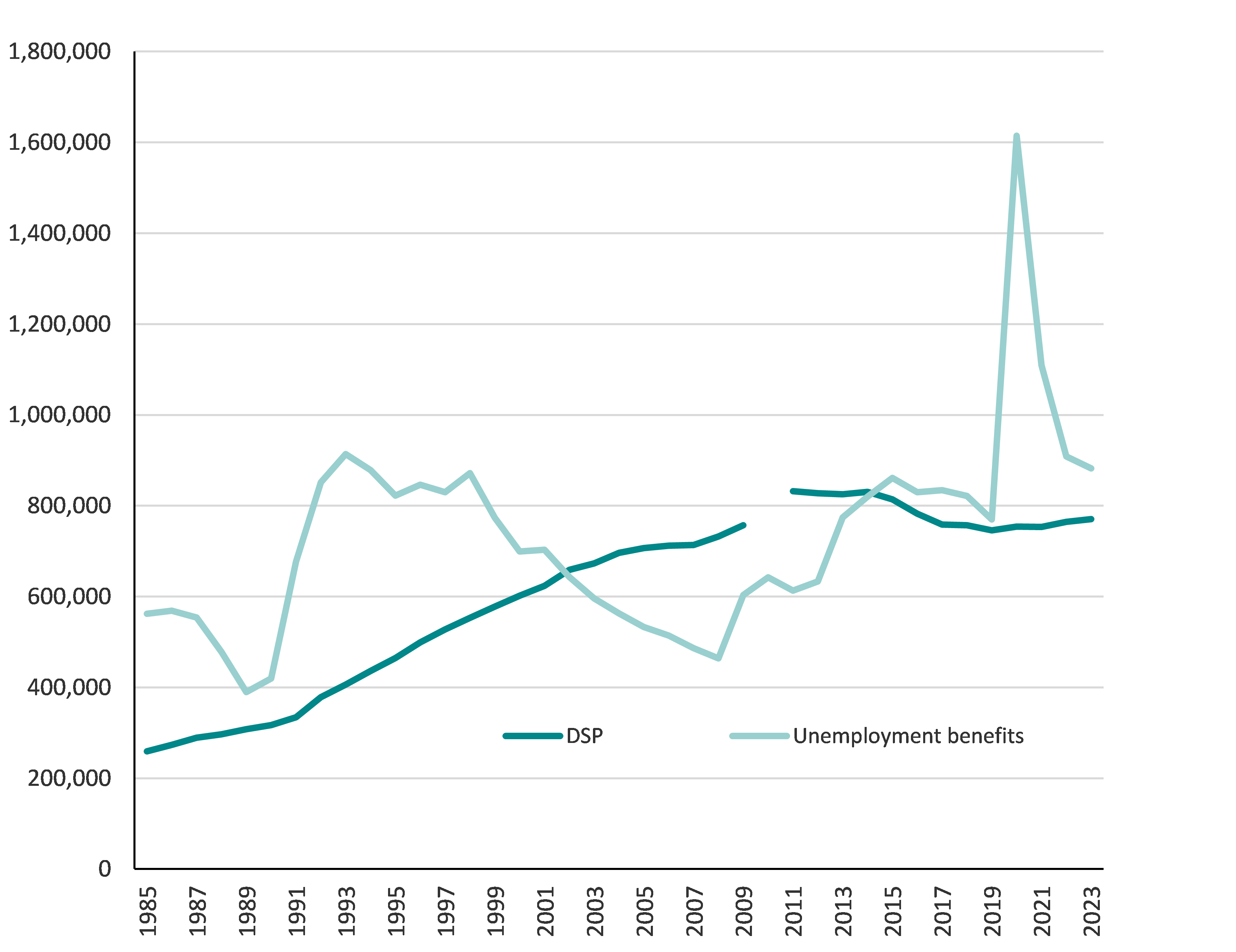Notes on the data: Income support
Disability support pensioners, June 2023
Policy context: People who are described as 'disability support pensioners' are those who receive a Disability Support Pension from the Department of Human Services (Centrelink).
The Disability Support Pension (DSP) provides an income to people who meet strict criteria under non-medical and medical rules. Non-medical rules include restrictions around age, residence status and income and assets. Medical rules, described as ‘manifest medical rules’ and general medical rules, can be viewed here.
Receipt of the DSP is strongly age-related, mainly because the incidence of disability rises with age [1]. In 2023, 3.0% of people aged 16 to 20 received DSP, increasing with age to 10.8% of people aged 25 to 34, 20.6% of people aged 45-54 and 32.5% of people aged 55-64 years [2]. Disability rises further with increasing age from 65 years, but after 65, most people are entitled to an Age Pension and the DSP is currently no longer relevant, dropping to 16.4%.
There has been a steady increase in the number of people receiving the DSP since its introduction, however a range of changes to policy including changes to assessment processes and workforce participation requirements saw a decrease in 2014, followed by a levelling out, in the number of recipients (see chart). Although the number of people on the DSP was similar to that on an unemployment benefit in 2019 (746,000 and 770,000 respectively), that changed dramatically in 2020 under the impact of the COVID-19 pandemic, as can be seen in the chart for the points for 2020 and 2021, although the numbers have since declined to be closer to the pre-pandemic level.

Notes:
Data sourced by PHIDU from documents from the Department of Social Services and its predecessors (titled 'monthly average unemployment to 2012' and 'Newstart and Youth Allowance (other)' for 2013 and later years): note that JobSeeker Payment replaced Newstart allowance from 20 March 2020.
Data for ‘unemployment benefits’ include Job Seeker Payment (Newstart Allowance before 20 March 2020) and Youth Allowance (other).
References
- Whiteford P. The rise and fall of "welfare dependency" in Australia. Melbourne: Brotherhood of St Laurence; 2013.
- 2. Department of Social Services. DSS Demographics June 2023. Available from: https://data.gov.au/data/dataset/dss-payment-demographic-data, accessed 11 September 2023.
Notes:
Population Health Area (PHA) data were derived from publicly-available data that were already suppressed at the Statistical Area Level 2 (SA2). Therefore, if a PHA included an SA2 with suppressed data, there could be an undercount in the PHA. However, the loss of counts due to the use of this data set was negligible (less than 0.01% lost). As State and Territory totals were also provided, data in the ‘Unknown’ data row in the Excel data workbooks are calculated as the difference between the sum of the PHA data and the State/Territory totals; these figures therefore include the sum of the suppressed SA2 cells.
Data cells with counts of less than five were suppressed (confidentialised).
Geography: Data available by Population Health Area, Local Government Area, Primary Health Network, Quintile of socioeconomic disadvantage of area and Quintiles within PHNs, and Remoteness Area
Numerator: People in receipt of a Disability Support Pension from Centrelink at June 2022
Denominator: People aged 16 to 64 years at June 2021 (population data at June 2022 not available at time of publication)
Detail of analysis: Per cent
Source: Compiled by PHIDU based on data from DSS Payment Demographic Data, June 2022, available from https://data.gov.au/data/dataset/dss-payment-demographic-data, accessed 22 March 2023 and Australian Bureau of Statistics Estimated Resident Population, 30 June 2021.
© PHIDU, Torrens University Australia ![]() This content is licensed under a Creative Commons Attribution-NonCommercial-ShareAlike 3.0 Australia licence.
This content is licensed under a Creative Commons Attribution-NonCommercial-ShareAlike 3.0 Australia licence.

